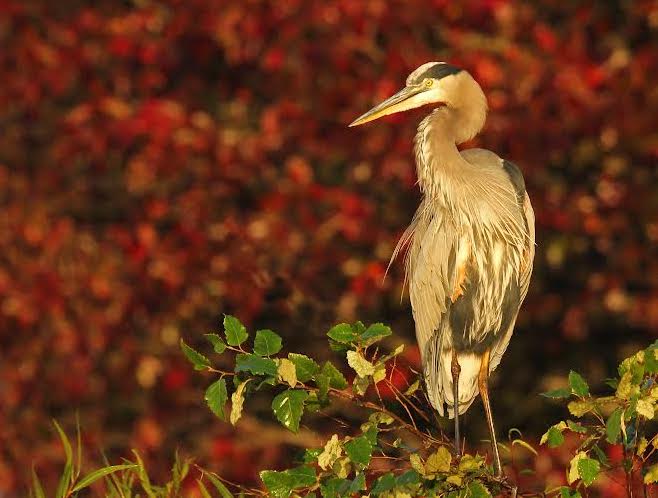Humans aren’t the only anglers to wade area trout streams hoping to land a trophy catch. One of the most efficient anglers in the state wears feathers instead of hip boots and never worries about what size of tippet to use. This two-legged fisherman is the great blue heron (Ardea herodias).
Herons are equipped with long legs for wading and a long, pointy bill for grabbing or spearing prey. Standing up to 4 feet tall and having a wingspan of 6 feet, the great blue heron is our largest heron, as well as the largest breeding bird in Pennsylvania.
From a distance, this large heron is blue-gray in appearance, but a closer inspection with binoculars reveals a nearly white head with a black stripe extending from its bill through its eye. Many people mistakenly call this bird a crane, but cranes are another family of long-legged, but non-wading birds. Cranes fly with their necks outstretched, while the heron folds its neck and rests its head against its shoulders as it flies.
Besides trout streams, herons also frequent fish hatcheries, beaver ponds, swamps, rivers and lake edges. They are often seen standing motionless while they stare into the water looking for a meal. If a fish happens to swim within range, the predator thrusts its head and neck forward like a striking snake. Herons use their beaks to capture their prey. Sources claim that they always grab their prey, but I have seen many stab wounds in trout, and I have photos showing the stabbing.
Adult great blue herons can swallow a 12-inch trout, but most of their diet consists of fish less than 3 inches long. They also eat frogs, tadpoles, snakes, crayfish and small rodents. Just last week, my daughter and I saw one trying to swallow what looked like a 14-inch fish.
Great blue herons are regular visitors at the Bald Eagle Sportsmen Cooperative Trout Nursery. I have seen as many as 14 there at one time. Although most of the nursery’s raceways are heron proof, the birds kill and eat many trout from the edges of the uncovered ponds.
Eagles and herons do not seem to get along. A few years ago, while kayaking the Frankstown Branch of the Juniata River, we kayakers kept flushing what was probably the same heron as we drifted down the river. Each time, it would fly farther downstream and then we would flush it again. That was until all of a sudden, the great blue screeched its shrill alarm call. We looked up to see the heron flying upriver — directly towards us with a mature bald eagle in hot pursuit. The frightened heron veered to our left and the eagle few right over our heads. This close encounter with two feathered predators was the highlight of our trip.
Great blue herons are found throughout most of North America, but they weren’t always as common as they are today. Water pollution, unregulated shooting and habitat destruction have greatly reduced their numbers. By 1900, they were nearly eliminated from our state. Habitat protection, increasing numbers of beavers, regenerating forests and the ban of DDT probably helped their recovery.
Herons nest in the tops of tall trees in secluded forest habitat — often in noisy groups. There is a heron rockery near Sinking Creek, and I am aware of another one just across the county line into Blair County. Most herons fly south for the winter, but some great blues overwinter if there is open water for feeding.
In Pennsylvania, great blue herons are seen in every county but are most common in the northwest and least common in the soft-coal counties. Acid mine drainage in counties such as Somerset, Indiana and Clearfield kills fish and amphibians and eliminates feeding areas. Great blue herons have significantly increased their numbers in the state during the past 35 years. In fact, Breeding Bird Survey data suggest that the population doubled between 1989 and 2009.



